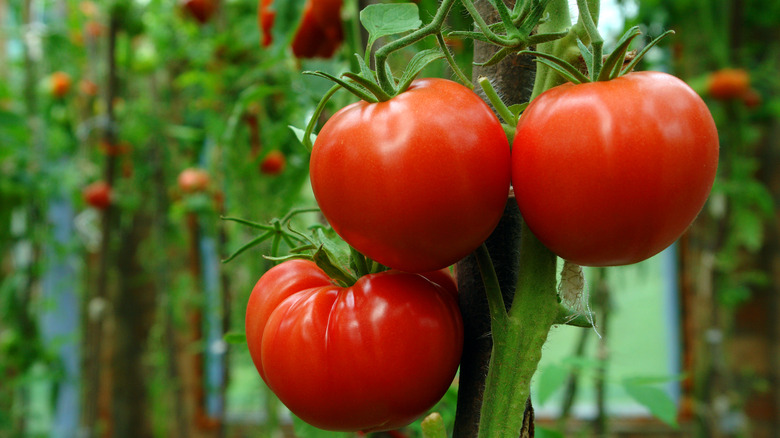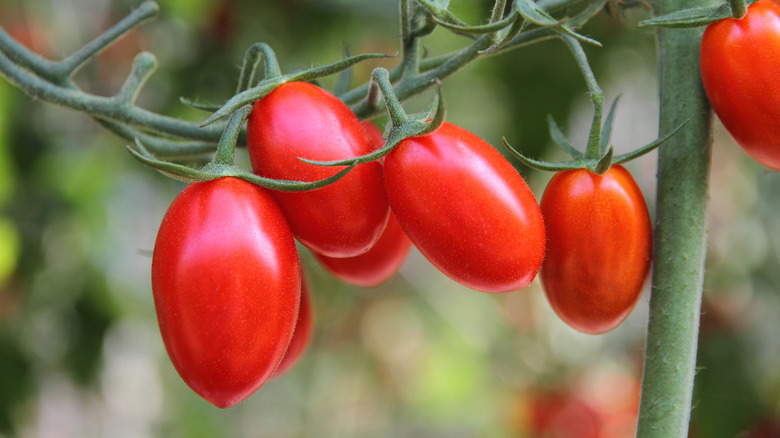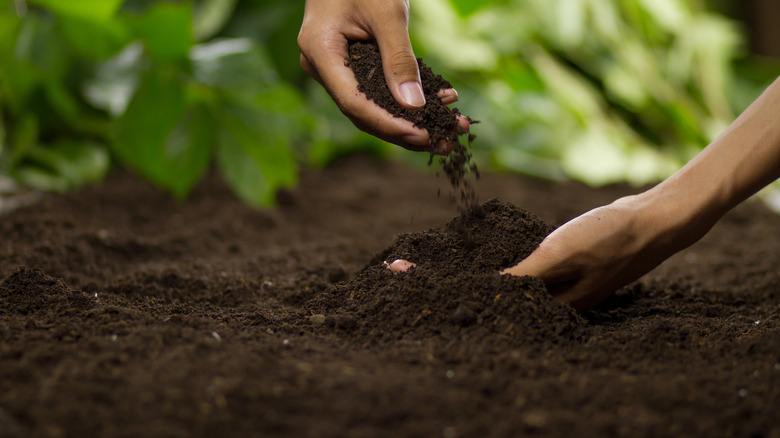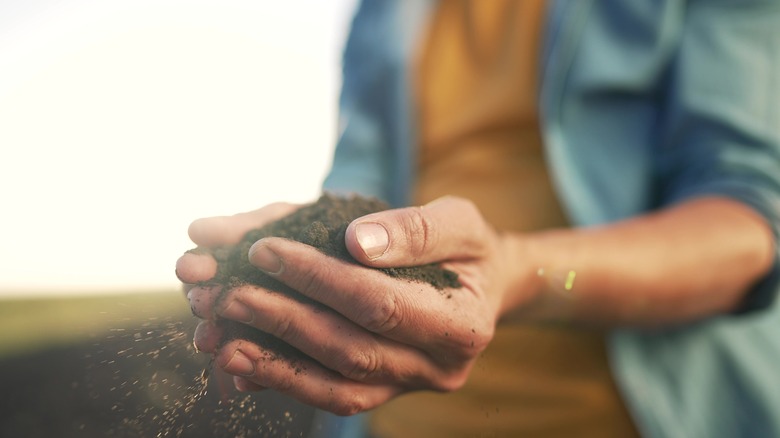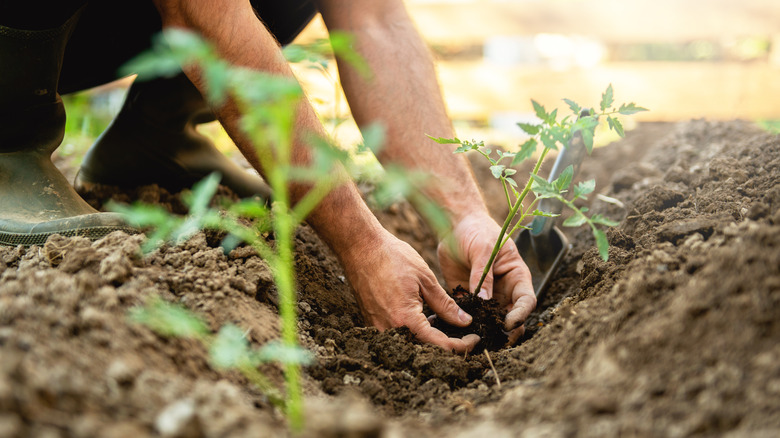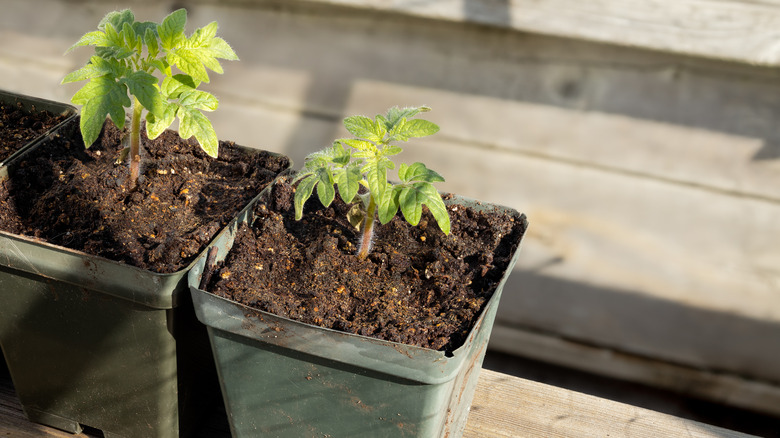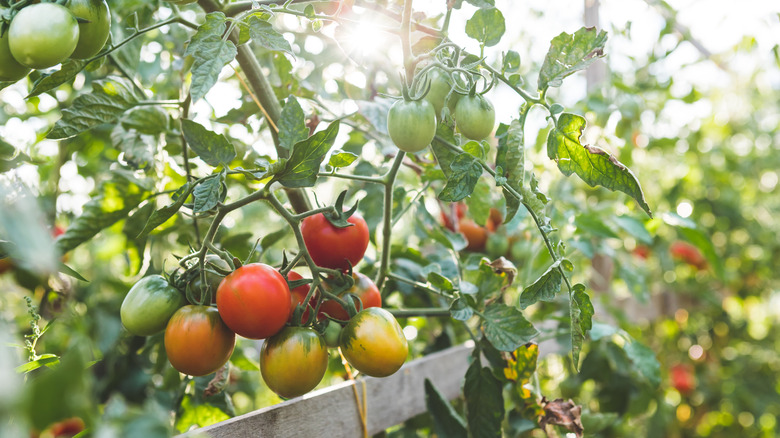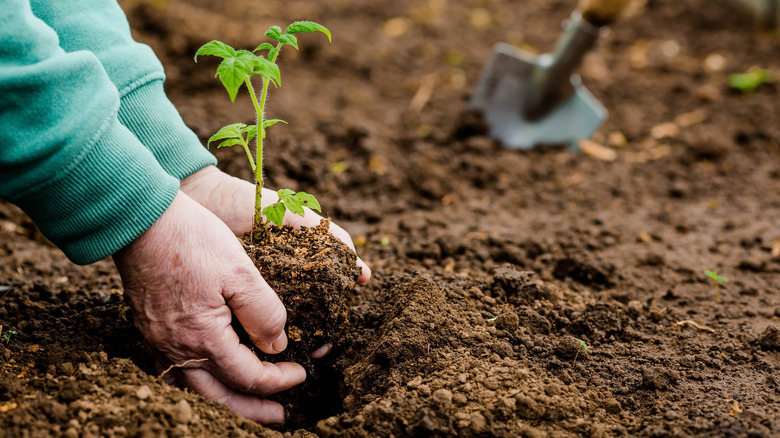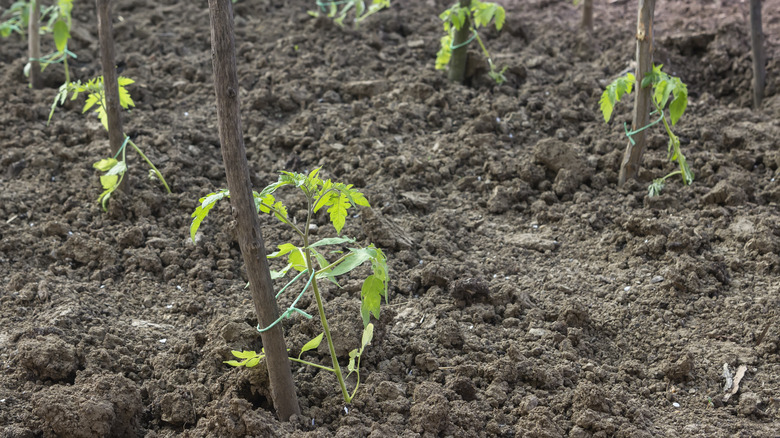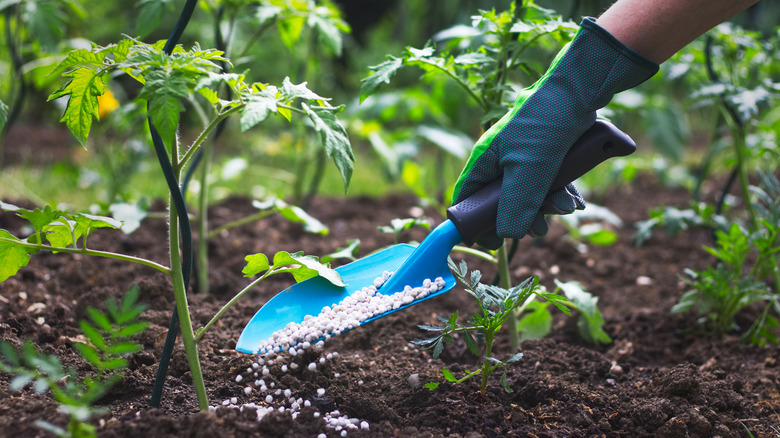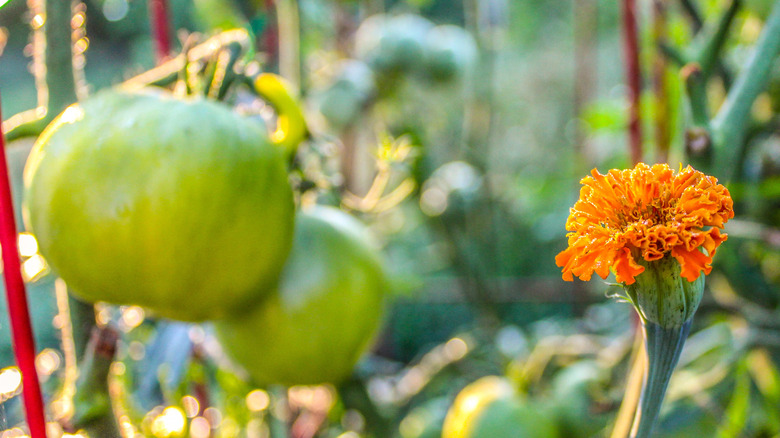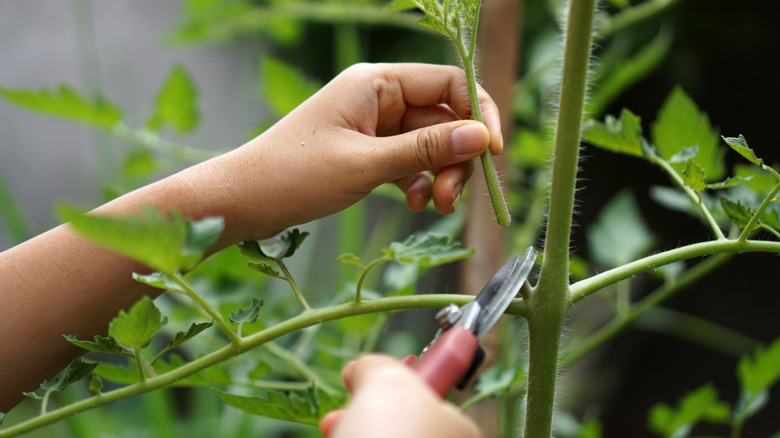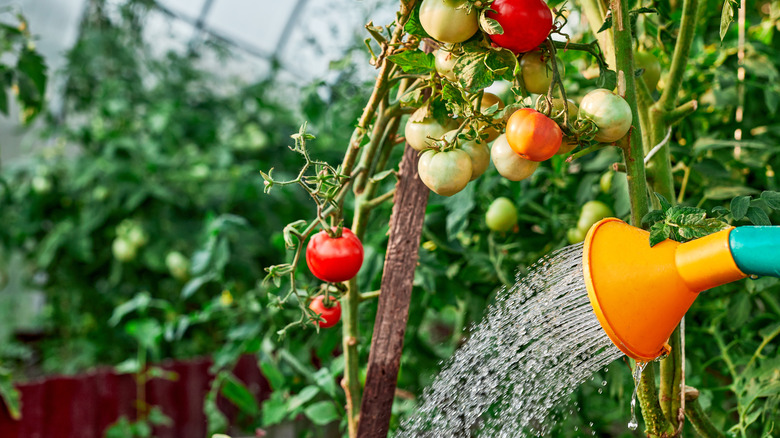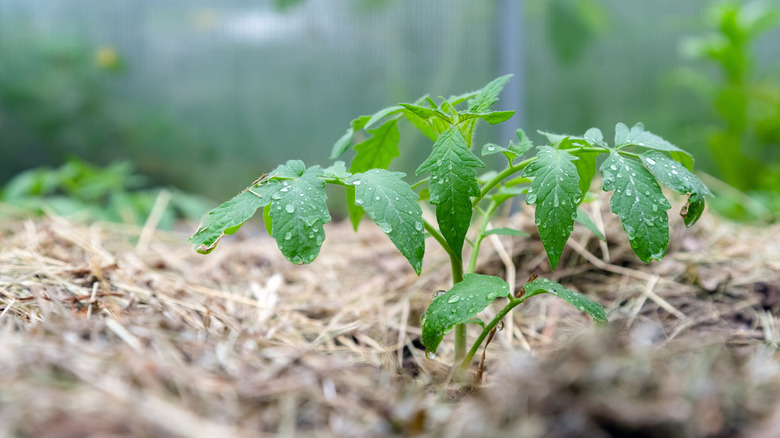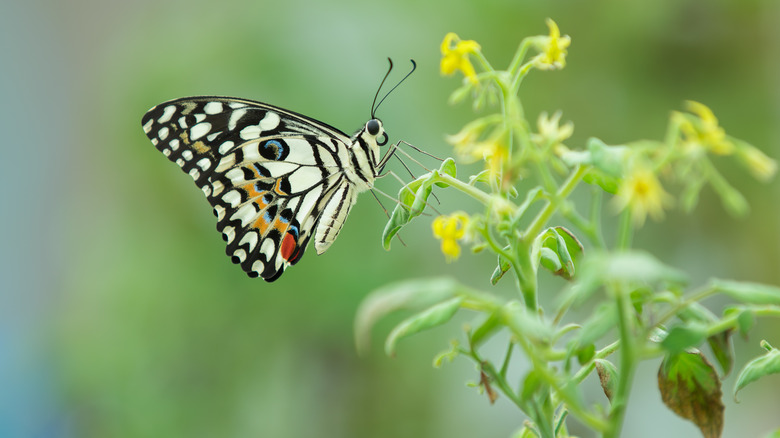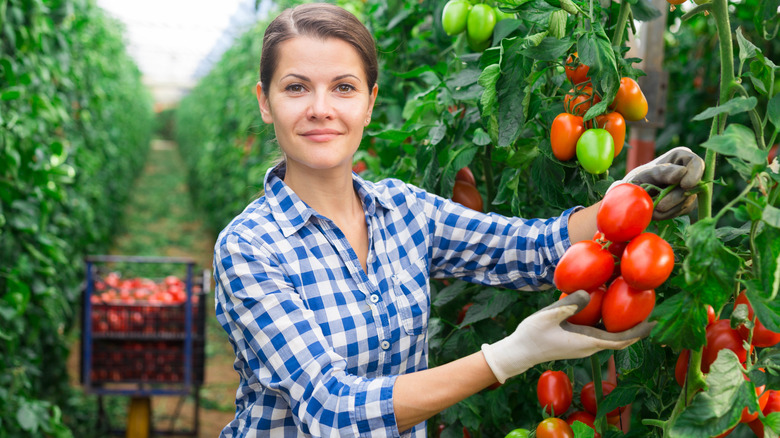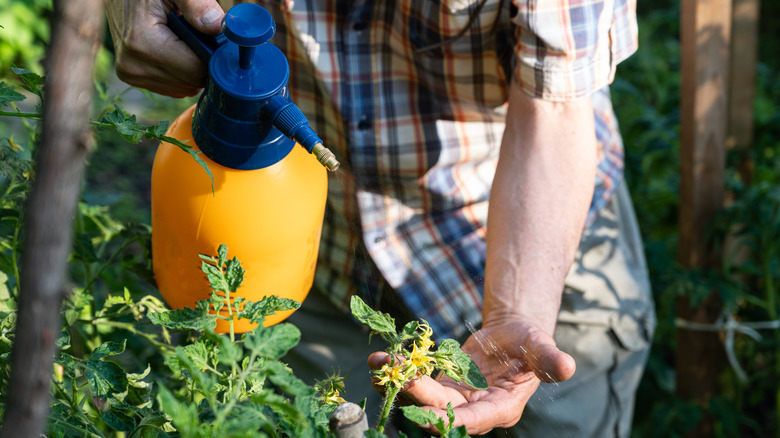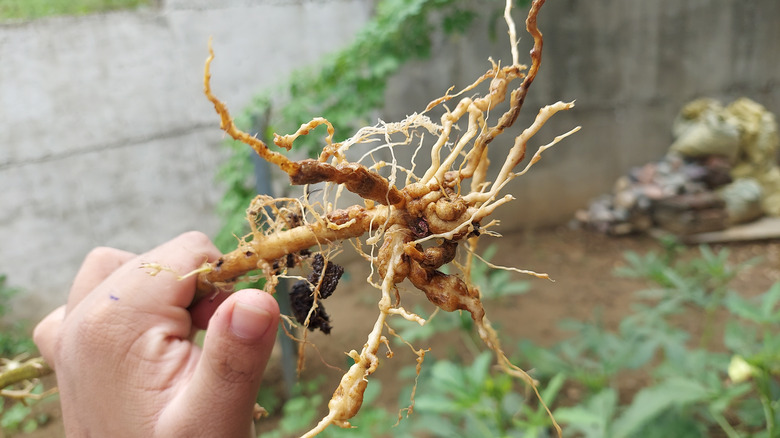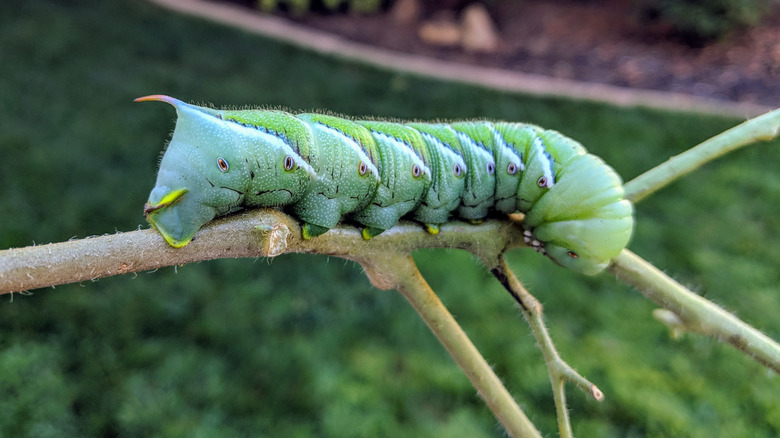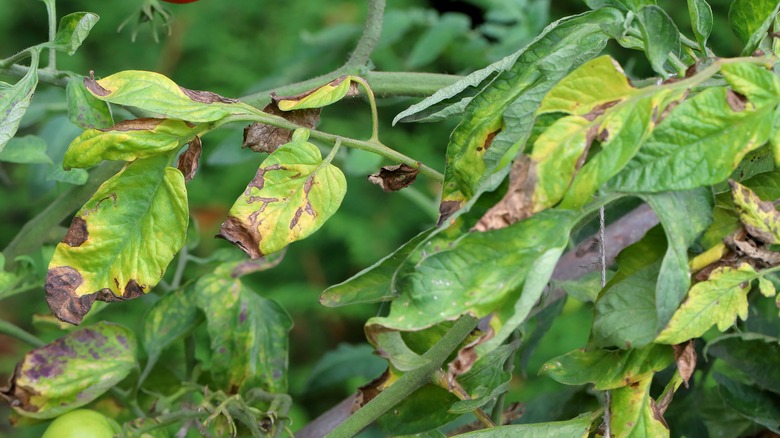19 Tips For Growing The Best Tomatoes In Your Garden
There's nothing like eating a fresh, ripe tomato that you've grown yourself in your garden. Many home gardeners enjoy growing tomatoes for the delicious bounty when it comes time to harvest them. Tomatoes not only bring color and flavor to the table, they are also nutritious. According to Medical News Today, they contain antioxidants like vitamin C, which may be helpful in fighting cancer. In addition, they are a good source of lycopene, a compound that can help protect your eyes. Furthermore, the potassium in tomatoes could help improve your heart health, and the water and fiber in them helps promote healthy digestion.
While tomato plants can bring yummy rewards to the table, they need the right conditions to survive, per How Stuff Works. From the best kind of soil you'll need to when and how to water them, we've compiled a collection of 16 tips for growing the best tomatoes.
1. Select the right tomato variety for your climate
To make things easier right off the bat, you should only plant tomatoes that are suitable for your climate. Cool-climate tomatoes do best in areas that don't have a long growing season while hot-climate tomatoes do better in, you guessed it, areas that have warmer seasons. Gardening Know How explains that you can also look for other varieties, such as those that resist disease or produce the right kind of fruit. For example, if you plan on making sauces, you may want to go with roma or plum tomatoes, while cherry tomatoes offer a sweet flavor for all kinds of dishes, per Almanac. Determinate varieties take up less space, and are best for canning or making sauces.
2. Prepare the soil for tomato plants
People make many mistakes when planting tomatoes, including when choosing soil. Tomatoes need slightly acidic soil that drains well. The University of New Hampshire suggests planting your tomatoes in a soil with a pH range from 6.2 to 6.8. A lack of nitrogen will make your plants grow lovely leaves, but very little in terms of fruit. The best way to know the pH levels of your soil is to have it tested, but if you cannot do that, apply 2.5 pounds of a 10-10-10 fertilizer per every 100 square feet of garden area into the soil two weeks before planting.
3. Warm up your soil before planting
Tomato plants can germinate within a week when planted in soil that is between 70 and 80 degrees Fahrenheit, according to Week&. While tomatoes will grow in cooler soil, it will take longer for the seeds to germinate. If you want your tomatoes to germinate quickly, try to warm the soil to 85 degrees Fahrenheit.
Planters and raised garden beds can be a great option to warm the soil more quickly, or covering your soil in clear plastic can help absorb the sun's heat. If you keep mulch over your garden, push it aside so the soil is in direct sunlight.
4. Give tomato seedlings plenty of room
When growing tomato seedlings, keep in mind that they like their own space — even when they are young. Tight spaces might stress tomato plants, making them susceptible to disease, according to The Spruce. For best results, plant seeds in different containers after they grow their first true leaves. Once outside, they need plenty of room to grow. Gardening Know How explains that a general rule of thumb is to leave 24 to 36 inches between each plant. Generous spacing allows light to make it to the lower leaves of the plant.
5. Harden off your tomato plants
All seedlings are sensitive, and tomatoes are no different. When you are ready to move them outside, you should prepare them for the upcoming temperature changes. According to SFGate, exposing the plants to cold temperatures can affect their growth rate and how they produce fruit later on. You should also cut back on water and fertilizer one week before moving the plants outdoors. Move the seedlings to a shelter outside when the temperature will be over 60 degrees. Move them back in for the night, and after a week, move the plants outside again and leave them out overnight if the temperature is not expected to fall below 50 degrees. Leave them outside for about a week before transplanting them.
6. Plant tomatoes where they will get lots of sun
When growing tomatoes from seeds, it's important to give the baby plants plenty of direct light. The Spruce recommends 14 to 18 hours of light per day is good. If necessary, use artificial lighting. If you are using fluorescent grow lights, keep the plants a couple of inches away from the lights, adjusting the space as the plants grow taller. When they are ready to go outside, place the plants in the sunniest part of your garden. SFGate notes that mature tomato plants need at least eight hours of sun per day, with morning light preferred. If your afternoons get sunny, make sure you give your plants some sort of shade to bear the higher temperatures.
7. Plant your tomato plants deep in the soil
The Spruce points out that tomatoes grow roots from all parts of their stem, so the part of the stem that is underground will grow roots, providing support for the plant. More roots means that your plant will have more opportunities to consume water and other nutrients from the soil. Deep roots means that your plant has more opportunities to find water. The Spruce recommends burying your plant in a hole up to the bottom of the healthiest leaves on the plant, and removing any small leaves that you intend on burying. Always loosen the root ball before planting and water the plant immediately after transplanting. Carefully place any stakes or cages to avoid damaging the root ball.
8. Support your tomato plants
When your tomato plants get big enough, they will need support. Better Homes & Gardens recommends staking plants early to prevent root damage later on. You can do this with either stakes, cages, or something else. The University of Georgia explains that some cages are not strong enough to support large tomato varieties, and stakes may be more useful. Tomato cages should be 5 to 6 feet tall, while stakes should be at least 8 feet tall. Make sure the support is deep in the ground to bear the weight of a full-grown plant without tipping over. Staking encourages growth, but it also protects plants from many ground-level diseases and pests.
9. Fertilize your tomato plants
Tomatoes are heavy feeders, meaning they need lots of nutrients to grow. The kind of fertilizer you'll need depends on the variety of plants you are growing and the pH level of your soil. Gardening Know How suggests testing your soil. Soil with high nitrogen needs a fertilizer that is low in nitrogen and high in phosphorus. If your soil needs nitrogen, then a balanced fertilizer like 8-8-8 or 10-10-10 should work well. If you see too much foliage and no fruit, you may need to cut back on nitrogen. Fertilize plants when you begin to see the first fruit. Spread fertilizer about 6 inches from the base of your plants to avoid damaging the stem with fertilizer.
10. Grow companion plants with your tomatoes
With a little help from some plant friends, you might be able to help your tomato plants produce fruit. Companion planting is a tried and true technique that can work to your advantages. Some plants, like chives and asparagus, repel insects that harm tomato plants. According to Gardening Know How, garlic's odor repels pests. Tall tomato plants provide shade for spinach, arugula, and lettuce. Asparagus repels worms that feast on tomato plants. Herbs offer benefits, too. Borage and marigold repels the tomato hornworm. Parsley and mint deter other pests, and if you grow basil near your tomatoes, it will increase their flavor.
11. Prune your tomato plants
It might seem contrary to prune your plants when you see them flourishing, but The Spruce maintains that if you don't, you may have trouble later on. Pruning forces your plant to utilize its energy to make fruit instead of leaves. Pruning also allows for better airflow, which can prevent fungus problems on lower leaves. The only time pruning isn't beneficial is with determinate tomato plants because they grow all their fruit at once. Start by removing "suckers," or the small stems that grow between the main stem and branches when they are small. Don't remove too many suckers or stems at once because this can stress the plant.
12. Water your tomato plants diligently
Tomato plants need plenty of water and moist soil. This can be difficult to maintain outside, so it pays to be diligent. During summer months, or when it rains less than 1 inch of rain per week, Better Homes & Gardens recommends watering your plants, either with a sprinkler, an irrigation system, or by hand. SFGate suggests watering 1 to 2 inches per week and saturating the soil when doing so. In the middle of summer, you may need to water your plants more often, and the only way to know how much water they need is to watch them. Water them if they begin to droop or if the soil is dry to the touch.
13. Mulch your tomato plants
Mulching prevents weeds from sprouting up around your tomato plants, and it keeps the soil from drying out, according to Agri Farming. You have several different options when it comes to what to use for a mulch. If you use straw, stack it anywhere from 3 to 6 inches tall around the plants. Composted leaves, wood chips, and grass clippings are excellent mulch. Landscape fabric is another choice, but keep in mind darker colors heat the soil. Other options include peat moss, pine bark, and pine bark. Keep any mulch away from the stem of the plants to avoid the spread of any disease.
14. Give your tomato plants a hand in pollination
News flash: Bonnie Plants has discovered that self-pollination can be difficult or impossible for tomatoes when faced with high temperatures (around 85 to 90 degrees Fahrenheit) or high humidity. When this happens continuously, your plants will not grow fruits in abundance. So you see why you need to give those red juicy tomato producers a hand. And guess what? All you have to do is grow plants near your tomatoes that attract natural pollinators like bees to your garden. Some of these plants include sunflowers, Chinese bell flowers, lavender, and others recommended by Safer Brand.
15. Don't leave blossoms hanging
In order to plant tomatoes successfully, gardeners and hobbyists should keep a close watch on their tomato plants in order to pick the fruits off their stalks once they are ready. Additionally, leaving blossoms hanging will hinder the circulation of nutrients to the areas where nutrients are the most needed (especially in young fruits). And if your plants happen to wind up with an abundance of green tomatoes, go ahead to pluck them off the vine and then ripen, as recommended by Empress Of Dirt.
16. Be careful with pest sprays
Pest attacks on tomatoes are often inevitable –– yes, even in gardens protected against an invasion. The thing is, no defense mechanism put in place can effectively hold down the over 20 different kinds of pesky pests that love chowing down on tomato plants (per All About Gardening). And while you may soon find yourself shopping for pest sprays to combat an attack, AARP warns against the indiscriminate use of those sprays. They mentioned that sprays should never be used when your plants have set fruits. At this stage, pests should be located, hand-picked, and killed off-garden.
17. Rotate your garden periodically to prevent nematodes
One of the most devastating things that can happen to your tomato crop is root-knot nematodes. According to Clemson Cooperative Extension, these microscopic organisms attack the roots of your tomato plant, and the only way you'll know if you have them is to examine plant roots. If your plants become discolored, stunted, or wilt easily in the heat, and nothing you've tried is working, take a look at the roots. Nematodes look like small balls or knots on the roots. Rotating your garden every three years will prevent nematodes from making a home in a particular area. The University of Florida suggests planting cowpea, sunn hemp, sorghum-sudangrass, marigold, jointvetch, velvetbean, hairy indigo, castor, sesame, and red clover to help deal with the problem.
18. Check often for tomato hornworms
Speaking of problems, the tomato hornworm is one of the worst. These bright green worms blend with the plant, so you need to examine them carefully. Missing foliage is a sign they have arrived. The Missouri Botanical Garden suggests checking plants early in the morning and simply destroying them. Chemicals such as Sevin may work, but they might also reduce the amount of beneficial insects your garden needs. Tilling garden soil in the winter helps control larvae. If you see a worm with small with white specs on its back, let it be. The specs are actually larvae from a wasp that will hatch and eventually help you control the worm population.
19. Watch for other problems
Hornworms aren't the only problems you might encounter with tomato plants. If you see blossom end rot, make sure the plants are getting enough water. The University of Minnesota recommends removing any leaves or fruit that have blossom end rot. Avoid getting the leaves wet when watering, and water in the morning so leaves can dry during the day. Wilting plants might mean your plants have bacterial wilt, which comes from the soil, according to Clemson Cooperative Extension. To avoid bacterial wilt, rotate the soil and avoid planting tomato plants with other susceptible plants, such as eggplant, potatoes, and pepper plants. Blight looks like small brown spots on leaves, and avoiding wet leaves and keeping potassium levels in the soil down can help.
